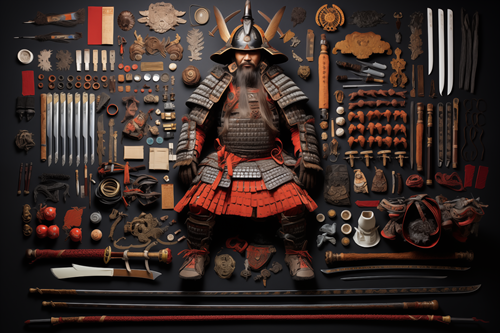The samurai, Japan's revered warrior class, have long captured the world's imagination with their martial prowess, unwavering code of honor, andistinctive attire. In this exploration of knolling, an artful arrangement of objects, we invite you to envision a Japanese samurai warrior standing amidst his attire. As we meticulously lay out the elements of this tableau, we'll also delve into the profound role that the samurai played in Japanese history and culture.
I. The Knolling Arrangement
Imagine a captivating tableau where a Japanese samurai stands in stoic reverence, surrounded by the essential components of his identity and duty.
-
The Samurai: At the center of the composition stands our samurai, his posture poised and dignified. He radiates an aura of discipline and unwavering loyalty to the code of Bushido.
-
The Katana: To his side, the samurai's katana rests in its scabbard, symbolizing his commitment to the way of the warrior. This sword, renowned for its craftsmanship and sharpness, embodies the samurai's dedication to the art of the blade.
-
The Wakizashi: A smaller sword, the wakizashi, accompanies the katana, representing the samurai's readiness for close combat and his duty to protect his lord.
-
The Kabuto: Behind the samurai, his ornate helmet, or kabuto, is displayed prominently. It is adorned with family crests and a menacing faceplate, reflecting his lineage and instilling fear in his enemies.
-
The Yoroi: Resting on a stand nearby is a suit of traditional samurai armor, or yoroi. Its lacquered plates and silk cords are meticulously arranged, symbolizing protection, strength, and prestige.
-
The Tengu-Getta: Below the armor, the samurai's wooden clogs, or tengu-geta, rest neatly. These elevated footwear allowed the samurai to navigate muddy terrain while maintaining an imposing height.
-
The Tatami: The tableau is set against a backdrop of tatami mats, signifying the traditional Japanese living space and martial arts practice area. It reminds us of the samurai's constant training and discipline.
II. The Samurai's Role
Beyond the artful arrangement, understanding the samurai's profound role in Japanese history and culture is essential.
-
Protectors and Warriors: Samurai, meaning "those who serve," were the elite warriors of feudal Japan. They served their lords (daimyo) with unwavering loyalty and were tasked with protecting their domains.
-
The Bushido Code: Central to the samurai ethos was the Bushido code, a set of principles that governed their actions. Honor, loyalty, courage, and self-discipline were its core tenets.
-
Cultural Patrons: Samurai played a pivotal role in promoting Japanese culture. They were patrons of the arts, fostering traditional practices such as tea ceremonies, calligraphy, and ikebana (flower arranging).
-
Symbol of Authority: The samurai represented authority and order in a society marked by tumultuous power struggles. They upheld justice and maintained stability during periods of civil unrest.
-
Endurance and Adaptability: Samurai faced not only external threats but also internal challenges as their role evolved. Many adapted to new roles as administrators and bureaucrats during times of peace.
-
Modern Influence: The legacy of the samurai endures in modern Japan, where their ideals continue to shape the nation's values and identity.
In conclusion, the knolling tableau of a Japanese samurai warrior amidst his attire is not just a visual arrangement of objects; it represents the heart and soul of a culture deeply rooted in tradition, honor, and duty. Beyond the meticulous placement of elements, it serves as a symbol of the samurai's enduring legacy—a testament to their pivotal role in Japanese history and their lasting influence on the world's perception of Japan and its warrior spirit.
Buy Traditional Japanese Katchu Samuria Warrior Merchandise


